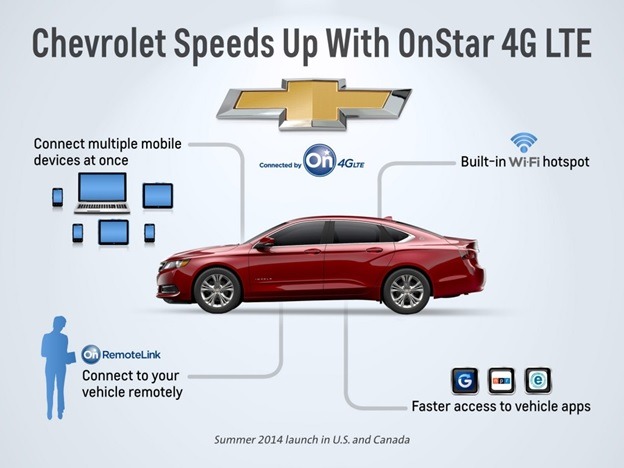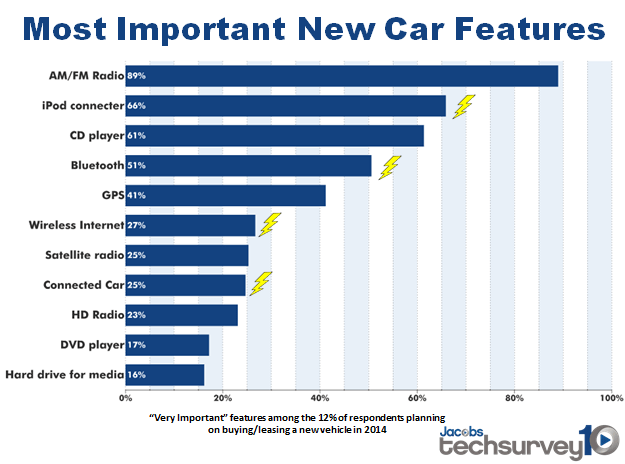If you’ve been following our Consumer Electronics Show and telematics conferences tours these past few years, you know the one thing we’ve learned about the “connected car” is that there’s no single pathway to success. The lack of standardization among the automakers and their suppliers was a big topic at DASH last October, because the many OEMs and Tier 1 companies are staunch competitors in a tech drag race to come up with “the answer” to the challenge of the digital dash.
GM started the connectivity sweepstakes with OnStar, while Ford pioneered the “connected car” platforms of today with SYNC. But since then, it’s been one innovation after another, with Apple and Google now vying to cement their brands in the “center stack” of new vehicles coming off the assembly lines.
Chevy has a unique way of standing out – they’re putting most of their chips on 4G LTE Wi-Fi, connecting all their vehicles from the Malibu to the Corvette.
Up to seven devices can be connected to the vehicle’s Wi-Fi hot spot, and it even functions when passengers are outside the vehicle (but still in the vicinity).
I don’t have to tell you just how powerful this technology is, and what a game-changer it can turn out to be for consumers, advertisers, and mobile app developers.
Yes, there are ongoing safety concerns, just as there is with the “connected car” in general. More and more, consumers are mesmerized by the beautiful displays in the center of their dashboards – and it’s not just the infotainment part that is potentially dangerous. Even functions like mapping and climate control create the potential for distraction. But take a look around you on your way to or from work today – look at the vehicles next to you, whether you’re stopped at a light or driving 70 MPH. Chances are, nearby drivers are checking their phones, whether they’re driving a “connected car” or they’re cruising around in a 10-year old vehicle with a basic radio/CD configuration.
We all want to be connected. In this year’s Techsurvey10, we isolated the group that’s in the market for a new vehicle in 2014 and asked them to list the most important features of their next vehicle. Once you get beyond the AM/FM radio (yes, in every survey you see, it’s #1), connectivity is a major priority. It comes in many forms from Bluetooth to an Aux In jack to WiFI to a full-blown entertainment system like Ford SYNC. You can see the growing demand for connectivity for features accompanied by a lighting bolt in the chart below:
A big part of what’s driving this demand is clearly marketing-oriented. The carmakers continue to get more sophisticated in amping up consumer interest. This new spot for Chevy’s Wi-Fi enabled vehicles is a case in point.
>EMAIL RECIPIENTS: CLICK HERE TO WATCH CHEVROLET VIDEO<
It is creative, clever, fun – and in a very unique way – juxtaposes our analog lives with our digital ones. It may remind you of an Apple commercial, and perhaps, that’s the point, too. Increasingly, Apple and Google will play roles in the “connected car” space, pushing the OEMs to step it up in the areas of both technology and marketing.
Radio can continue to be a major player in this dashboard drama, but much of that depends on how the industry plays its cards in the areas of educating itself about this technology, partnering with the auto companies, and reimaging its content in an increasingly crowded and options-oriented marketplace.
Join in on the conversation here on our blog, and make the commitment and by joining us at DASH this October for two days of amazing presentations, networking opportunities, and learning unlike any radio convention you’ve ever attended. Info here.
And in the meantime, keep your eyes on the road and your hands upon the wheel.
- Media And Technology In 2025: Believe It Or Not! - April 18, 2025
- In Radio, You Just Never Know - April 17, 2025
- The Secret To Making A Great Podcast (And Great Radio) - April 16, 2025






Fred. In my humble, the number of drivers with eyes fixed on their center consoles will probably go up rather than down. As more and more manufacturers incorporate sophisticated accident avoidance and prevention systems into their products, I’m thinking drivers will pay less attention to the road, assuming the car will take care of itself.
Ira, that may in fact be the plan. As consumers believe they’re safer in vehicles, it allows for distraction. Thanks for chiming in.